Collapse Fragility Analysis of RC Frame Structures Considering Capacity Uncertainty
Abstract
1. Introduction
2. Seismic Collapse Fragility Analysis Considering Uncertainty in the Bearing Capacity
2.1. Problem Description
2.2. Seismic Fragility Analysis of Structures Based on Seismic Reliability
2.2.1. Seismic Reliability Analysis Based on the Fractional Exponential Moments-Based Maximum Entropy Method
2.2.2. Fragility Curve Fitting Based on Shift Generalized Lognormal Distribution
3. Proposed Method
3.1. Definition of the Collapse Point
3.2. Engineering Demand Parameters Analyzing
3.3. Fragility Analysis Based on the CPI
4. Case Analysis
4.1. OpenSees Model of a RC Frame
4.2. Stochastic Ground Motions Generation
4.3. Distribution of the Maximum Inter-Story Drift Ratios at the Collapse Point
4.4. Seismic Collapse Fragility Curve
5. Results and Discussion
- (1)
- According to the time history analysis results, the structural bearing capacity is not a definite value, which shows a certain distribution pattern. The uncertainty of the bearing capacity has a significant impact on the fragility of the structure. Compared to the inter-story drift ratio limits of 1/25 and 1/50, the median collapse IMs considering the uncertainty of the bearing capacity has increased by 13.2% and 87.3%, respectively.
- (2)
- The lognormal fragility model exhibits a poor fit for the failure probability obtained through the seismic reliability method. Compared to the fragility function assumed by the lognormal, using the SGLD as the fragility function model can more accurately reconstruct the fragility curve. The SGLD is more flexible and more universal in different fragility analysis scenarios.
- (3)
- The failure probability obtained by considering the uncertainty of the bearing capacity is lower than the failure probability obtained based on the deterministic threshold, and structural seismic risk assessment should consider the uncertainty of the bearing capacity.
Author Contributions
Funding
Data Availability Statement
Conflicts of Interest
References
- Barbat, A.H.; Moya, F.Y.; Canas, J.A. Damage Scenarios Simulation for Seismic Risk Assessment in Urban Zones. Earthq. Spectra 1996, 12, 371–394. [Google Scholar] [CrossRef]
- Fragility Analysis Methods: Review of Existing Approaches and Application. Nucl. Eng. Des. 2017, 323, 245–258. [CrossRef]
- Ruggieri, S.; Calò, M.; Cardellicchio, A.; Uva, G. Analytical-Mechanical Based Framework for Seismic Overall Fragility Analysis of Existing RC Buildings in Town Compartments. Bull. Earthq. Eng. 2022, 20, 8179–8216. [Google Scholar] [CrossRef]
- Whitman, R.V.; Reed, J.W.; Hong, S.T. Earthquake Damage Probability Matrices; IIT Kanpur: Kanpur, India, 1974. [Google Scholar]
- Rossetto, T.; Elnashai, A. Derivation of Vulnerability Functions for European-Type RC Structures Based on Observational Data. Eng. Struct. 2003, 25, 1241–1263. [Google Scholar] [CrossRef]
- Vamvatsikos, D.; Cornell, C.A. Incremental Dynamic Analysis. Earthq. Eng. Struct. Dyn. 2002, 31, 491–514. [Google Scholar] [CrossRef]
- Vamvatsikos, D.; Cornell, C.A. The Incremental Dynamic Analysis and Its Application to Performance-Based Earthquake Engineering. In Proceedings of the 12th European Conference on Earthquake Engineering, London, UK, 9–13 September 2002. [Google Scholar]
- Scozzese, F.; Tubaldi, E.; Dall’Asta, A. Assessment of the Effectiveness of Multiple-Stripe Analysis by Using a Stochastic Earthquake Input Model. Bull. Earthq. Eng. 2020, 18, 3167–3203. [Google Scholar] [CrossRef]
- Ni, P.P.; Wang, S.H.; Jiang, L.; Huang, R.Q. Seismic Risk Assessment of Structures Using Multiple Stripe Analysis. Appl. Mech. Mater. 2012, 226–228, 897–900. [Google Scholar] [CrossRef]
- Jalayer, F.; De Risi, R.; Manfredi, G. Bayesian Cloud Analysis: Efficient Structural Fragility Assessment Using Linear Regression. Bull. Earthq. Eng. 2015, 13, 1183–1203. [Google Scholar] [CrossRef]
- Nettis, A.; Gentile, R.; Raffaele, D.; Uva, G.; Galasso, C. Cloud Capacity Spectrum Method: Accounting for Record-to-Record Variability in Fragility Analysis Using Nonlinear Static Procedures. Soil Dyn. Earthq. Eng. 2021, 150, 106829. [Google Scholar] [CrossRef]
- Sainct, R.; Feau, C.; Martinez, J.-M.; Garnier, J. Efficient Methodology for Seismic Fragility Curves Estimation by Active Learning on Support Vector Machines. Struct. Saf. 2020, 86, 101972. [Google Scholar] [CrossRef]
- Kazemi, F.; Asgarkhani, N.; Jankowski, R. Machine Learning-Based Seismic Fragility and Seismic Vulnerability Assessment of Reinforced Concrete Structures. Soil Dyn. Earthq. Eng. 2023, 166, 107761. [Google Scholar] [CrossRef]
- Feng, D.-C.; Cao, X.-Y.; Wang, D.; Wu, G. A PDEM-Based Non-Parametric Seismic Fragility Assessment Method for RC Structures under Non-Stationary Ground Motions. J. Build. Eng. 2023, 63, 105465. [Google Scholar] [CrossRef]
- Liu, Z.; Zhang, Z. Artificial Neural Network Based Method for Seismic Fragility Analysis of Steel Frames. KSCE J. Civ. Eng. 2018, 22, 708–717. [Google Scholar] [CrossRef]
- Xu, J.; Liao, L.; Zhang, Y.; Wang, D. Efficient Seismic Fragility Analysis of Structures from Dynamic Reliability Perspective. Eng. Struct. 2022, 271, 114889. [Google Scholar] [CrossRef]
- Mai, C.; Konakli, K.; Sudret, B. Seismic Fragility Curves for Structures Using Non-Parametric Representations. Front. Struct. Civ. Eng. 2017, 11, 169–186. [Google Scholar] [CrossRef]
- Zheng, X.-W.; Li, H.-N.; Shi, Z.-Q. Hybrid AI-Bayesian-Based Demand Models and Fragility Estimates for Tall Buildings against Multi-Hazard of Earthquakes and Winds. Thin-Walled Struct. 2023, 187, 110749. [Google Scholar] [CrossRef]
- Wang, Q.; Geng, P.; Wang, L.; He, D.; Shen, H. Machine Learning-Driven Feature Importance Appraisal of Seismic Parameters on Tunnel Damage and Seismic Fragility Prediction. Eng. Appl. Artif. Intell. 2024, 137, 109101. [Google Scholar] [CrossRef]
- Wei, B.; Zheng, X.; Jiang, L.; Lai, Z.; Zhang, R.; Chen, J.; Yang, Z. Seismic Response Prediction and Fragility Assessment of High-Speed Railway Bridges Using Machine Learning Technology. Structures 2024, 66, 106845. [Google Scholar] [CrossRef]
- Bertero, V.V. Strength and Deformation Capacities of Buildings under Extreme Environments. Struct. Eng. Mech. 1977, 53, 211–215. [Google Scholar]
- FEMA. Recommended Seismic Design Criteria for New Steel Moment-Frame Buildings; Federal Emergency Management Agency: Washington, DC, USA, 2000.
- Fattahi, F.; Gholizadeh, S. Seismic Fragility Assessment of Optimally Designed Steel Moment Frames. Eng. Struct. 2019, 179, 37–51. [Google Scholar] [CrossRef]
- Cardone, D.; Perrone, G.; Piesco, V. Developing Collapse Fragility Curves for Base-Isolated Buildings. Earthq. Eng. Struct. Dyn. 2019, 48, 78–102. [Google Scholar] [CrossRef]
- Dabaghi, M.; Saad, G.; Allhassania, N. Seismic Collapse Fragility Analysis of Reinforced Concrete Shear Wall Buildings. Earthq. Spectra 2019, 35, 383–404. [Google Scholar] [CrossRef]
- Lu, X.; Gu, D.; Zhao, P.; Zhang, C.; Cheav, P.C. Performance-based design of building structures for collapse under earthquake. Build. Struct. 2022, 52, 50–57+133. (In Chinese) [Google Scholar] [CrossRef]
- Pourreza, F.; Mousazadeh, M.; Basim, M.C. An Efficient Method for Incorporating Modeling Uncertainties into Collapse Fragility of Steel Structures. Struct. Saf. 2021, 88, 102009. [Google Scholar] [CrossRef]
- Cao, X.-Y.; Feng, D.-C.; Beer, M. Consistent Seismic Hazard and Fragility Analysis Considering Combined Capacity-Demand Uncertainties via Probability Density Evolution Method. Struct. Saf. 2023, 103, 102330. [Google Scholar] [CrossRef]
- Jia, D.-W.; Wu, Z.-Y. Seismic Risk Analysis Based on Imprecise Distribution and Failure Probability Function under Multidimensional Limit State. Structures 2023, 50, 963–977. [Google Scholar] [CrossRef]
- He, S.; Xu, J.; Zhang, Y. Reliability Computation via a Transformed Mixed-Degree Cubature Rule and Maximum Entropy. Appl. Math. Model. 2022, 104, 122–139. [Google Scholar] [CrossRef]
- Li, G.; He, W.; Zeng, Y. An Improved Maximum Entropy Method via Fractional Moments with Laplace Transform for Reliability Analysis. Struct. Multidiscip. Optim. 2018, 59, 1301–1320. [Google Scholar] [CrossRef]
- Xu, J. A New Method for Reliability Assessment of Structural Dynamic Systems with Random Parameters. Struct. Saf. 2016, 60, 130–143. [Google Scholar] [CrossRef]
- Baker, J.W. Efficient Analytical Fragility Function Fitting Using Dynamic Structural Analysis. Earthq. Spectra 2015, 31, 579–599. [Google Scholar] [CrossRef]
- Jeon, J.-S.; Mangalathu, S.; Song, J.; Desroches, R. Parameterized Seismic Fragility Curves for Curved Multi-Frame Concrete Box-Girder Bridges Using Bayesian Parameter Estimation. J. Earthq. Eng. 2019, 23, 954–979. [Google Scholar] [CrossRef]
- Mangalathu, S.; Jeon, J.-S. Stripe-Based Fragility Analysis of Multispan Concrete Bridge Classes Using Machine Learning Techniques. Earthq. Eng. Struct. Dyn. 2019, 48, 1238–1255. [Google Scholar] [CrossRef]
- Low, Y.M. A New Distribution for Fitting Four Moments and Its Applications to Reliability Analysis. Struct. Saf. 2013, 42, 12–25. [Google Scholar] [CrossRef]
- Yuan, P.-T. On the Logarithmic Frequency Distribution and the Semi-Logarithmic Correlation Surface. Ann. Math. Statist. 1933, 4, 30–74. [Google Scholar] [CrossRef]
- Amin, M.; Ang Alfredo, H.S. Nonstationary Stochastic Models of Earthquake Motions. J. Eng. Mech. Div. 1968, 94, 559–584. [Google Scholar] [CrossRef]
- Yeh, C.-H.; Wen, Y.K. Modeling of Nonstationary Ground Motion and Analysis of Inelastic Structural Response. Struct. Saf. 1990, 8, 281–298. [Google Scholar] [CrossRef]
- Shinozuka, M.; Deodatis, G. Simulation of Stochastic Processes by Spectral Representation. Appl. Mech. Rev. 1991, 44, 191–204. [Google Scholar] [CrossRef]
- Liu, Z.; Liu, W.; Peng, Y. Random Function Based Spectral Representation of Stationary and Non-Stationary Stochastic Processes. Probabilistic Eng. Mech. 2016, 45, 115–126. [Google Scholar] [CrossRef]
- Clough, R.W.; Penzien, J.; Griffin, D.S. Dynamics of Structures; Prentice Hall: Hoboken, NJ, USA, 1990. [Google Scholar]
- Xu, J.; Feng, D.-C. Stochastic Dynamic Response Analysis and Reliability Assessment of Non-Linear Structures under Fully Non-Stationary Ground Motions. Struct. Saf. 2019, 79, 94–106. [Google Scholar] [CrossRef]
- Yang, Q.; Tian, Y. Earthquake Ground Motions & Artificial Generation; Science Press: Beijing, China, 2014. [Google Scholar]
- Yu, X.; Lu, D.; Li, B. Relating Seismic Design Level and Seismic Performance: Fragility-Based Investigation of RC Moment-Resisting Frame Buildings in China. J. Perform. Constr. Facil. 2017, 31, 04017075. [Google Scholar] [CrossRef]
- GB50011; Code for Seismic Design of Buildings. Standardization Administration of China: Beijing, China, 2010.
- Scott, B.; Park, R.; Priestley, M.J.N. Stress-Strain Behavior of Concrete Confined by Overlapping Hoops at Low and High Strain Rates. ACI J. Proc. 1982, 79, 13–27. [Google Scholar] [CrossRef]
- Cao, X.-Y.; Wu, G.; Ju, J.-W.W. Seismic Performance Improvement of Existing RCFs Using External PT-PBSPC Frame Sub-Structures: Experimental Verification and Numerical Investigation. J. Build. Eng. 2022, 46, 103649. [Google Scholar] [CrossRef]
- Liu, Z.; Zeng, B.; Wu, L. Simulation of non stationary ground motion by spectral representation and random functions . J. Vib. Eng. 2015, 28, 411–417. (In Chinese) [Google Scholar] [CrossRef]
- FEMA. Quantification of Building Seismic Performance Factors; Federal Emergency Management Agency: Washington, DC, USA, 2009.
- Xu, J.; Dang, C. A Novel Fractional Moments-Based Maximum Entropy Method for High-Dimensional Reliability Analysis. Appl. Math. Model. 2019, 75, 749–768. [Google Scholar] [CrossRef]
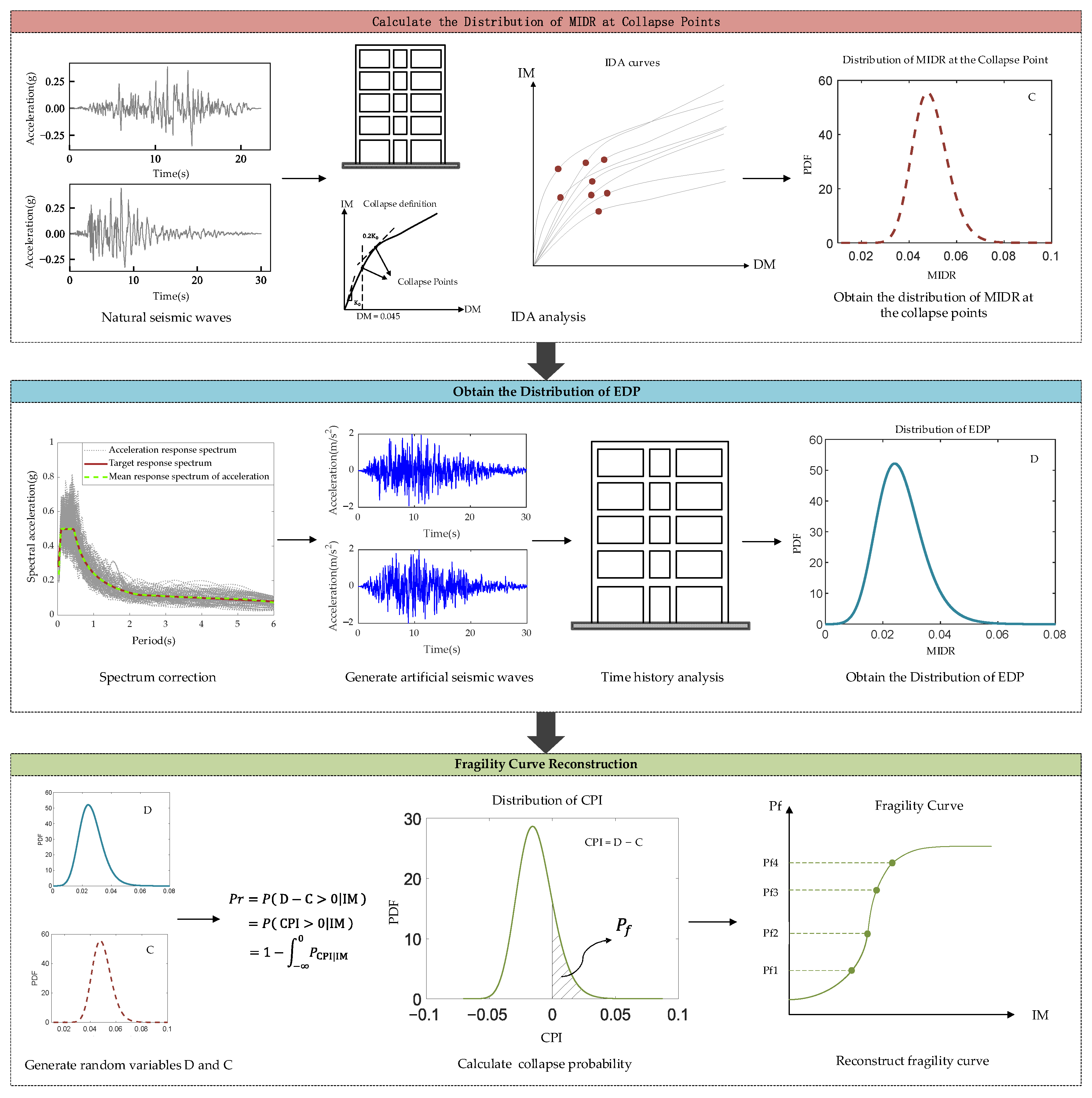
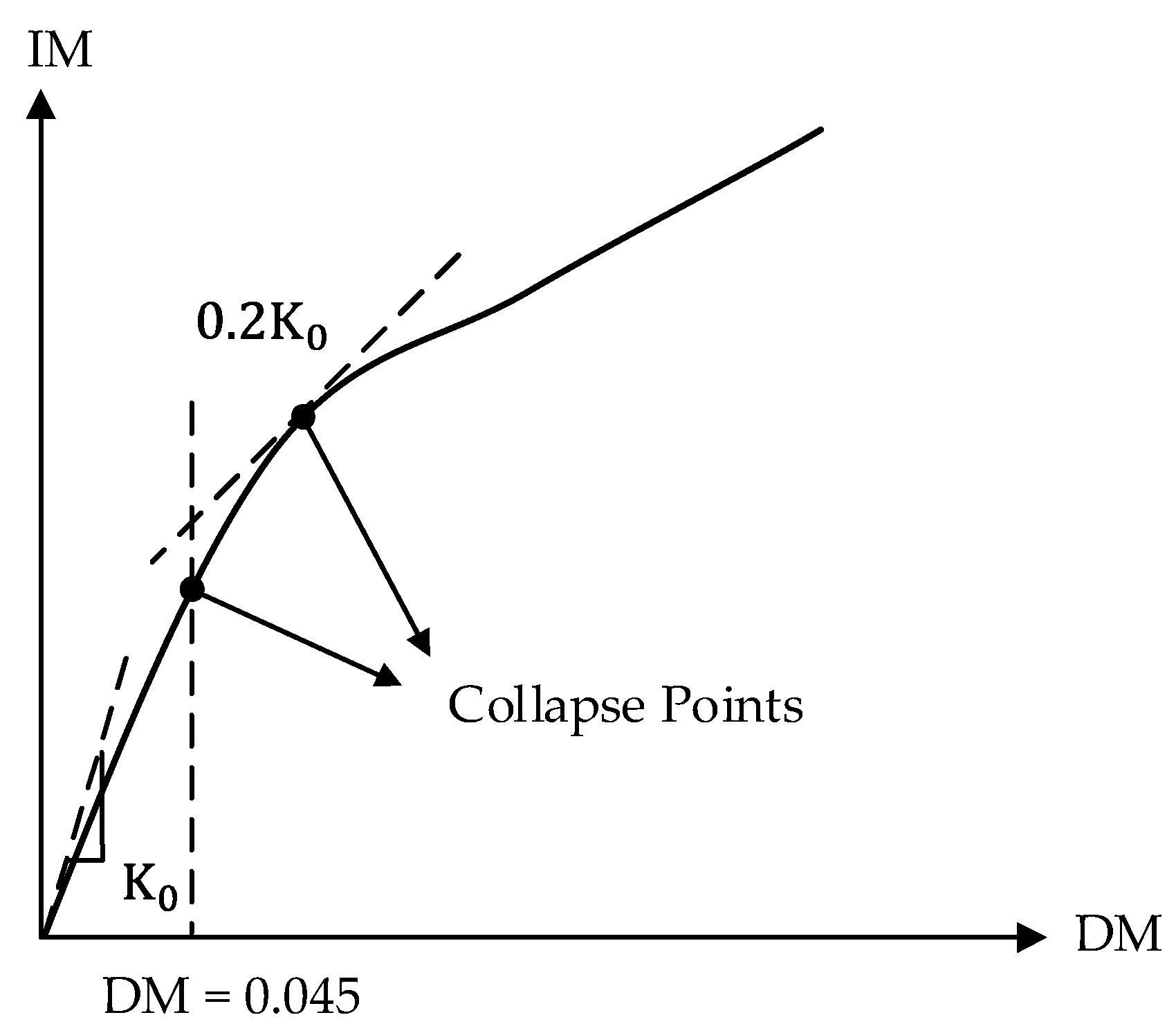
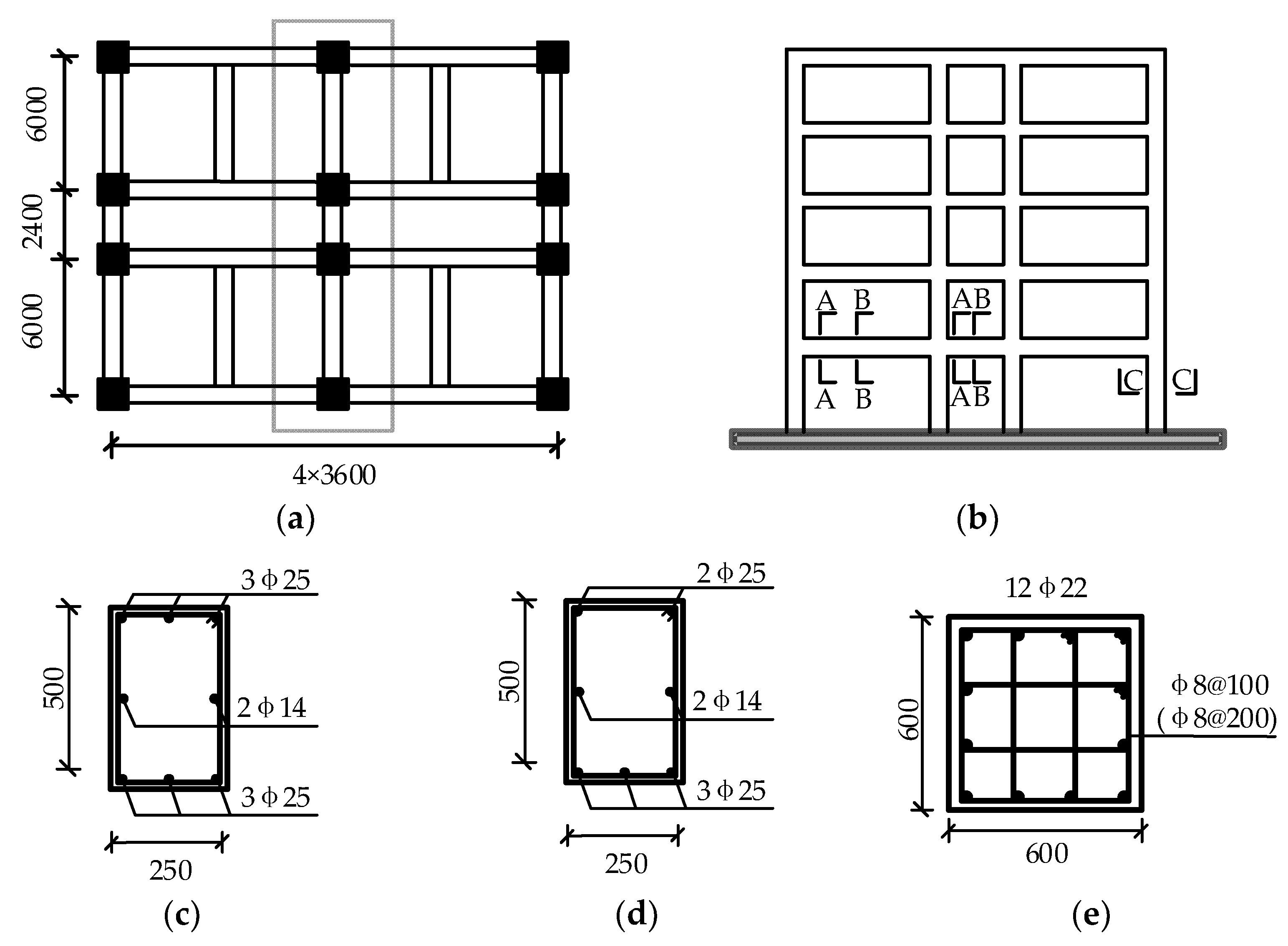

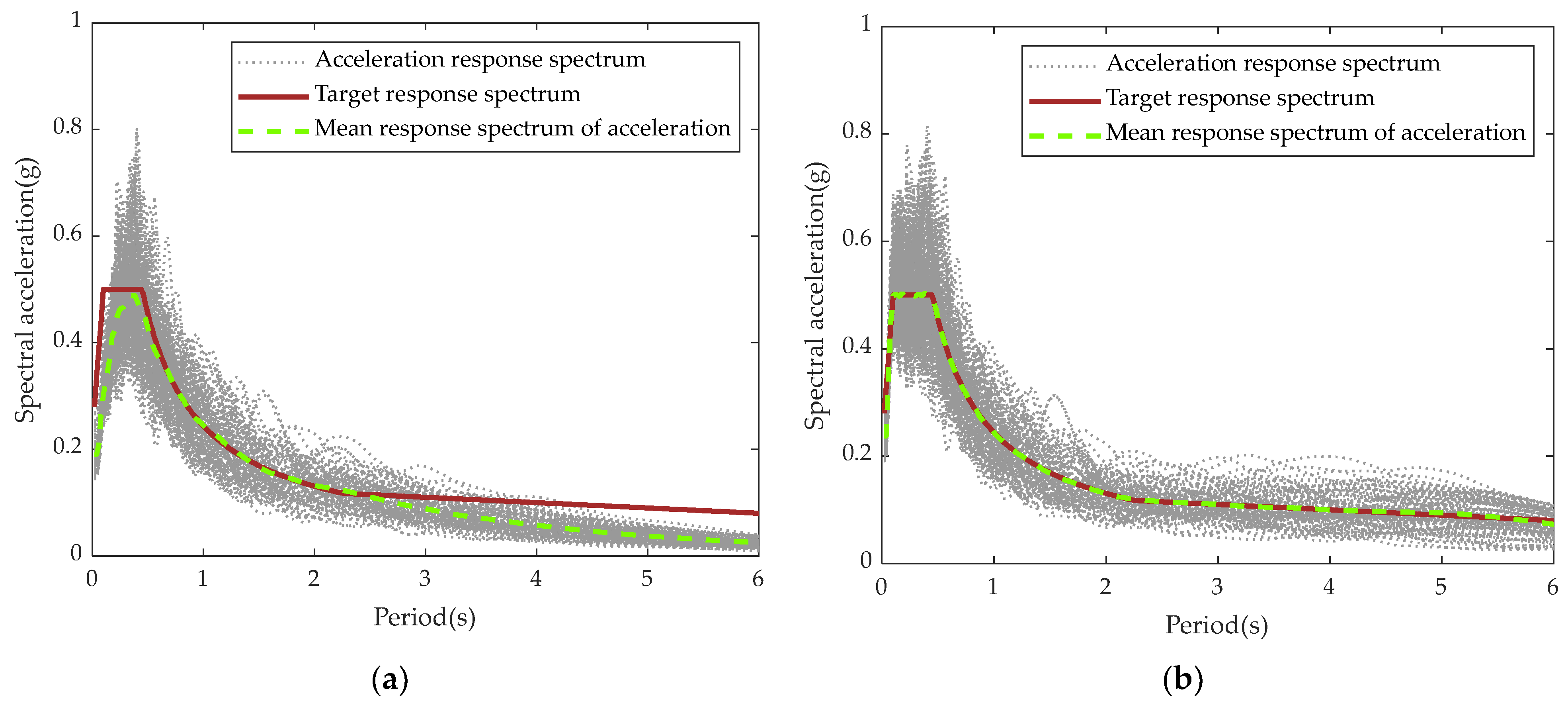
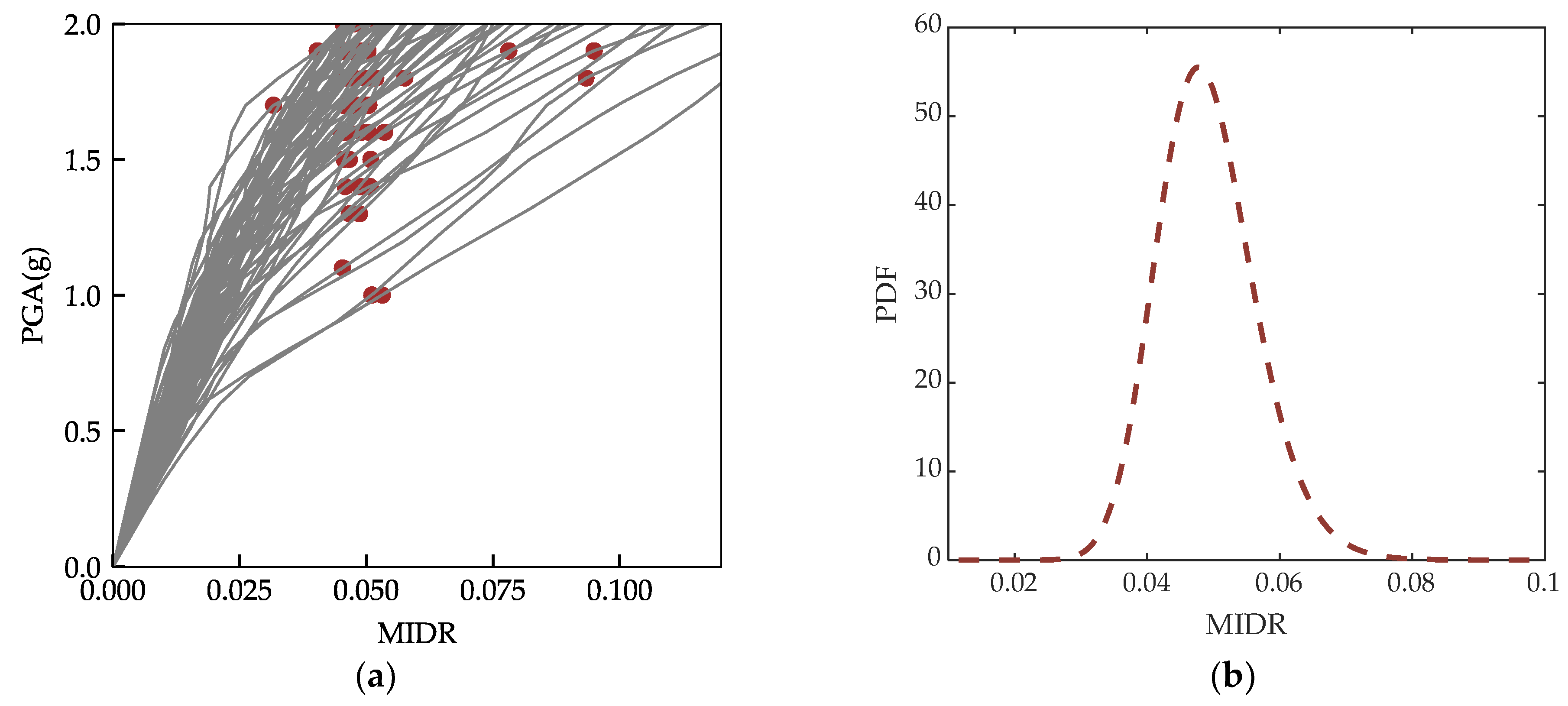


| Parameters | Description | Parameters | Description |
|---|---|---|---|
| Dominant frequency | Frequency interval | ||
| Parameter of the second filter binding the low-frequency | Average arrival time of PGA | ||
| Damping ratio of the site soil | Frequency modulation factor | ||
| Parameter of the second filter binding the low-frequency component | Duration time | ||
| PGA value | Shape control coefficient | ||
| Peak value factor | Discrete frequencies |
| IM(g) | 0.1 | 0.5 | 1.0 | 1.2 | 1.4 | 1.6 | 1.8 | 2.0 |
|---|---|---|---|---|---|---|---|---|
| Failure Prob. (CPI) | 0 | 0 | 0.0007 | 0.0240 | 0.1036 | 0.2551 | 0.4455 | 0.6113 |
| Failure Prob. (1/25) | 0 | 0 | 0.0037 | 0.0580 | 0.2232 | 0.4496 | 0.6556 | 0.7980 |
| Failure Prob. (1/50) | 0 | 0.0006 | 0.5121 | 0.7761 | 0.9019 | 0.9515 | 0.9759 | 0.9877 |
Disclaimer/Publisher’s Note: The statements, opinions and data contained in all publications are solely those of the individual author(s) and contributor(s) and not of MDPI and/or the editor(s). MDPI and/or the editor(s) disclaim responsibility for any injury to people or property resulting from any ideas, methods, instructions or products referred to in the content. |
© 2025 by the authors. Licensee MDPI, Basel, Switzerland. This article is an open access article distributed under the terms and conditions of the Creative Commons Attribution (CC BY) license (https://creativecommons.org/licenses/by/4.0/).
Share and Cite
Zeng, T.; Li, Y. Collapse Fragility Analysis of RC Frame Structures Considering Capacity Uncertainty. Buildings 2025, 15, 694. https://doi.org/10.3390/buildings15050694
Zeng T, Li Y. Collapse Fragility Analysis of RC Frame Structures Considering Capacity Uncertainty. Buildings. 2025; 15(5):694. https://doi.org/10.3390/buildings15050694
Chicago/Turabian StyleZeng, Tailin, and Yang Li. 2025. "Collapse Fragility Analysis of RC Frame Structures Considering Capacity Uncertainty" Buildings 15, no. 5: 694. https://doi.org/10.3390/buildings15050694
APA StyleZeng, T., & Li, Y. (2025). Collapse Fragility Analysis of RC Frame Structures Considering Capacity Uncertainty. Buildings, 15(5), 694. https://doi.org/10.3390/buildings15050694








